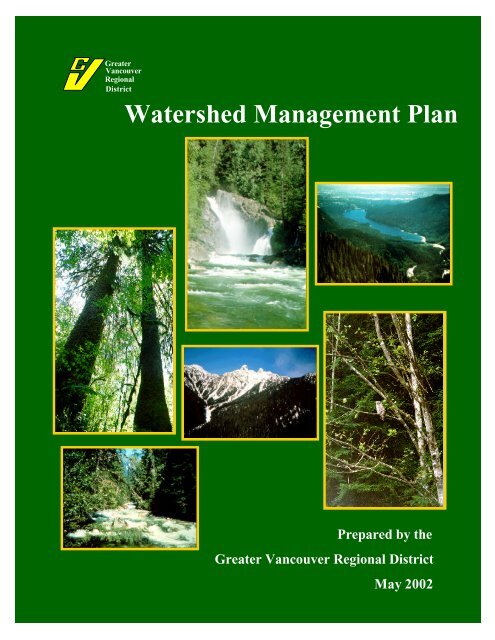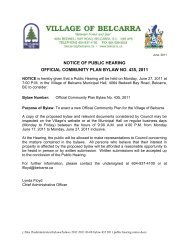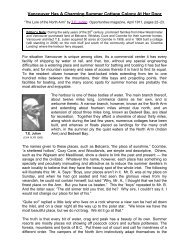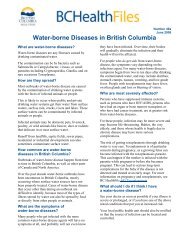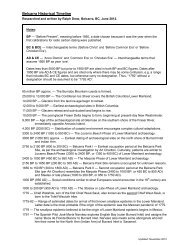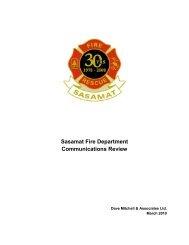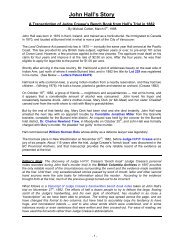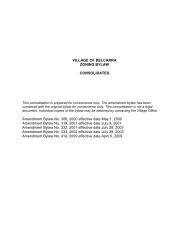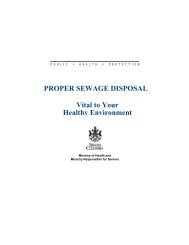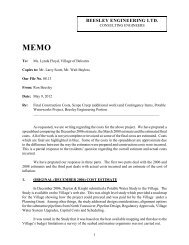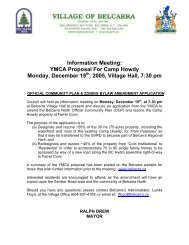Metro Vancouver's Watershed Management Plan
Metro Vancouver's Watershed Management Plan
Metro Vancouver's Watershed Management Plan
You also want an ePaper? Increase the reach of your titles
YUMPU automatically turns print PDFs into web optimized ePapers that Google loves.
Greater<br />
Vancouver<br />
Regional<br />
District<br />
<strong>Watershed</strong> <strong>Management</strong> <strong>Plan</strong><br />
Prepared by the<br />
Greater Vancouver Regional District<br />
May 2002
<strong>Watershed</strong> <strong>Management</strong> <strong>Plan</strong><br />
For more information, contact:<br />
GVRD Policy and <strong>Plan</strong>ning Department<br />
4330 Kingsway<br />
Burnaby, B.C.<br />
V5H 4G8<br />
Tel: (604) 432-6375 Fax: (604) 436-6970<br />
Web site: www.gvrd.bc.ca<br />
Greater<br />
Vancouver<br />
Regional<br />
District
TABLE OF CONTENTS<br />
TABLE OF CONTENTS ..........................................................................................................................................................1<br />
PURPOSE AND SCOPE...........................................................................................................................................................2<br />
GOAL .........................................................................................................................................................................................2<br />
PRINCIPLES .............................................................................................................................................................................2<br />
MANAGEMENT STRATEGIES.............................................................................................................................................5<br />
IMPLEMENTATION PROGRAMS.......................................................................................................................................6<br />
1. Water Monitoring & Forecasting...............................................................................................................................6<br />
2. Forest Ecosystem <strong>Management</strong>..................................................................................................................................6<br />
3. Fire <strong>Management</strong> .......................................................................................................................................................7<br />
4. Erosion Control..........................................................................................................................................................8<br />
5. Road Network.............................................................................................................................................................9<br />
6. Water System Infrastructure.....................................................................................................................................12<br />
7. Communication and Education ................................................................................................................................12<br />
8. <strong>Watershed</strong> Security...................................................................................................................................................13<br />
9. Emergency Preparedness.........................................................................................................................................13<br />
PLANNING PROCESS...........................................................................................................................................................14<br />
ADAPTIVE MANAGEMENT ...............................................................................................................................................16<br />
FIVE-YEAR IMPLEMENTATION PLAN ..........................................................................................................................16<br />
ANNUAL REPORT.................................................................................................................................................................16<br />
GLOSSARY .............................................................................................................................................................................17<br />
REFERENCES ........................................................................................................................................................................20<br />
MAPS<br />
MAP 1: Greater Vancouver <strong>Watershed</strong>s<br />
MAP 2: Biogeoclimatic Zones<br />
MAP 3: Road System
Purpose and Scope<br />
This document is a management plan for the three watersheds from which the Greater Vancouver Regional<br />
District and its affiliate, the Greater Vancouver Water District supply water to their members. This <strong>Plan</strong> is<br />
consistent with the intent of the Crown leases providing a long-term source of water supply and will constitute the<br />
basis for more detailed watershed, five-year implementation plans as well as related activities such as the<br />
preparation of water use plans.<br />
This <strong>Plan</strong> applies to both Crown and private lands held by the GVRD, that are on-drainage. The Lower Seymour<br />
Conservation Reserve (LSCR), is off-drainage and subject to a separate planning process. During the term of this<br />
<strong>Plan</strong>, the objectives for the Or Creek sub-watershed will be reviewed as the area is off-drainage and provides<br />
important fish habitat. In addition, the Grouse Mountain Recreation Area (GMRA) provides popular recreation<br />
facilities off-drainage and is not included in this <strong>Plan</strong>. The location of the GVRD’s Capilano, Seymour and<br />
Coquitlam watersheds, as well as the LSCR, Or Creek sub-watershed and GMRA, are shown on Map 1.<br />
The <strong>Plan</strong> is based upon the GVRD Board’s overall vision statement, Creating Our Future, which states that “The<br />
purpose of Greater Vancouver’s watersheds is to produce clean, safe water.” It is also based upon the Board’s<br />
regional growth strategy, the Livable Region Strategic <strong>Plan</strong>, which includes the watersheds in the regional Green<br />
Zone that is to be protected from urban development. These lands are included in the Green Zone because they<br />
are important to community health (water supply) and are ecologically important lands that are part of an<br />
integrated system of park/wilderness areas in the region.<br />
This <strong>Plan</strong> is an integral part of the multiple barrier approach that minimizes the risk to drinking water. The<br />
multiple barrier approach includes steps to protect the water at the source and throughout the system to the<br />
consumer. GVRD’s Drinking Water <strong>Management</strong> <strong>Plan</strong> is currently being developed to provide comprehensive<br />
long-term strategies for regional water supply.<br />
GOAL<br />
The Board’s overall Goal in this <strong>Plan</strong> is “<strong>Watershed</strong>s that provide clean, safe water and are managed and<br />
protected as natural assets of the highest importance to the Greater Vancouver region.”<br />
PRINCIPLES<br />
The management strategy for the watersheds will be based upon an ecologically sensitive and minimum<br />
intervention approach. The management strategies will be based on the five Principles endorsed by the GVRD<br />
Board in November 1999.<br />
1. The primary purpose of Greater Vancouver’s watersheds is to provide clean, safe water.<br />
Managing the watersheds on a risk management approach is used to minimize risks to water quality. Water<br />
quality issues occasionally initiate in the watersheds from time-to-time that can only be resolved by water<br />
treatment and by temporarily isolating the degraded water supply from the distribution system by switching the<br />
water supply to a cleaner and safer source.<br />
2. The watersheds will be managed to reflect and advance the region’s commitment to the environmental<br />
stewardship and protection of those lands and their biological diversity.<br />
As stated within the Green Zone Strategy Livable Region Strategic <strong>Plan</strong>, the watersheds provide an important<br />
opportunity for conserving lands in a natural state. <strong>Management</strong> strategies will promote forest conservation to<br />
maintain ecosystem integrity. Environmental stewardship initiatives will be undertaken to support fish, wildlife<br />
and biodiversity objectives.<br />
W ATERSHED M ANAGEMENT P LAN 2
3. The region’s <strong>Management</strong> <strong>Plan</strong> will be based upon the minimum intervention absolutely necessary to achieve the<br />
Board’s objectives.<br />
Minimum intervention is an effective means to manage the watershed. Strategies will focus on monitoring rather<br />
than intervention. Intervention strategies will only be prescribed after monitoring clearly identifies a need for<br />
intervention. Intervention will be continuously monitored to gauge the environmental performance of<br />
management activities. Knowledge gained from the monitoring will allow for adaptive management approaches<br />
to be implemented.<br />
4. The <strong>Management</strong> <strong>Plan</strong> will contain policies to return areas disturbed by human activities as close as possible to<br />
the pre-disturbance state consistent with the primary goal of protecting water quality.<br />
Disturbances in the watersheds initiated by human activities can result in impacts to water quality. Areas<br />
disturbed by human activities will be restored to their natural state where the disturbances are impacting water<br />
quality. <strong>Management</strong> activities will be based on approaches that mimic ecosystem processes.<br />
5. The decision making process will be transparent and open to the public.<br />
In addition to being involved in watershed management planning processes, the public will be invited to<br />
participate in community watershed stewardship initiatives. These will include the involvement of interest groups<br />
and education and research organizations to engage in activities such as monitoring programs. Information<br />
regarding the management activities will be widely available and openly discussed.<br />
3<br />
W ATERSHED M ANAGEMENT P LAN
W ATERSHED M ANAGEMENT P LAN 2
<strong>Watershed</strong> <strong>Management</strong> <strong>Plan</strong> 4
<strong>Watershed</strong> <strong>Management</strong> <strong>Plan</strong> 4
MANAGEMENT STRATEGIES<br />
The five Principles allow natural processes to prevail to the greatest possible extent, given the overall Goal. The<br />
management strategies link the Goal and Principles to specific implementation programs. Monitoring of water<br />
and ecosystem processes will guide these management strategies.<br />
1. Adaptive management<br />
The GVRD will manage the watersheds through an adaptive approach, in which incremental steps will be taken<br />
and periodically assessed to ascertain whether they are consistent with the Goal and Principles of this <strong>Plan</strong>.<br />
2. Water infrastructure development consistent with the Goal<br />
In constructing works within the watersheds, the GVRD and other utilities (e.g. BC Hydro, Centra Gas) will have<br />
regard to the Goal and the Principles of this <strong>Plan</strong>.<br />
3. Restoration of natural systems<br />
The GVRD will, over time, re-establish the natural regimes that existed in the watersheds prior to their<br />
disturbance by human activity if the disturbance is impacting water quality, including watercourses, roads and<br />
cleared areas.<br />
4. Support for natural processes consistent with water quality, safety and environmental quality<br />
The GVRD will permit natural processes, such as forest succession, interactions of plants and animals, wildfires,<br />
and erosion, to take place without intervention unless these processes constitute a threat to water quality, public<br />
safety or the environment. These natural processes support biodiversity and provide for valuable ecosystem<br />
services.<br />
5. Stewardship guided by research, monitoring and public involvement<br />
The GVRD will continually develop and disseminate the body of knowledge about the watersheds and will<br />
engage the public in understanding the implications of this information for watershed management.<br />
6. Cost-effective management<br />
The GVRD will plan and implement its watershed management strategies and programs in a way that balances the<br />
achievement of the Goal with the financial constraints of the GVRD.<br />
7. Co-ordinate with Provincial strategies and policies<br />
The GVRD will consider legislation and policy in its planning and operations, and will meet or exceed applicable<br />
standards for maintaining ecosystems in the watersheds.<br />
<strong>Watershed</strong> <strong>Management</strong> <strong>Plan</strong> 5
IMPLEMENTATION PROGRAMS<br />
This strategic <strong>Plan</strong> will guide the direction of the watershed implementation<br />
programs. Programs will be conducted cautiously by utilizing adaptive<br />
management, risk assessment and ongoing monitoring to measure the<br />
consequences of the implementation program. This will ensure that<br />
appropriate management practices are continually employed and revised as<br />
necessary. Results of the implementation programs will be documented in<br />
an annual state of the watershed report.<br />
1. Water Monitoring & Forecasting<br />
Objective: Verify that the watersheds will continue to provide an adequate<br />
supply of clean safe water for the water system.<br />
Palisade Lake – alpine reservoir<br />
Water monitoring and forecasting will provide essential data to forecast<br />
water supply quantities. Currently the watersheds provide approximately<br />
400 million cubic meters of drinking water to the region, which represents<br />
21 percent of the mean annual inflow. Water quality is continuously<br />
assessed at various locations throughout the watersheds to evaluate the<br />
effectiveness of management strategies.<br />
Seymour River – hydrometric Station<br />
A series of weather, hydrometric, and sediment monitoring stations within<br />
the watersheds provide valuable information for watershed management<br />
decision-making. Weather stations measure rainfall and snow<br />
accumulations. The maintenance of long-term weather data is important to<br />
evaluate potential impacts from climate change. Hydrometric stations<br />
provide information on water inflow to the reservoirs, sediment input from<br />
various sub-drainages within the watersheds, and early warning of high<br />
turbidity events. Sediment stations characterize water quality conditions<br />
and assist in determining if mitigation measures are warranted. Periodic<br />
water samples from various locations in the watersheds are also analyzed<br />
for microorganisms that may provide risk to water quality.<br />
2. Forest Ecosystem <strong>Management</strong><br />
Objective: Minimize the amount of human induced disturbances to the<br />
forest ecosystem.<br />
The forest ecosystem will be conserved to ensure that the complexities,<br />
interactions and functions are sustained into the future that will maintain<br />
biodiversity and provide for ecosystem services. In addition, the forest<br />
ecosystem regulates runoff and minimizes soil erosion.<br />
Conserving forest ecosystems throughout the watersheds supports the<br />
Green Zone Strategy, Livable Region Strategic <strong>Plan</strong> by maintaining<br />
important ecological functions for habitats and biodiversity. Other<br />
W ATERSHED M ANAGEMENT P LAN 6
watershed resources influenced by the forest ecosystems include aquatic<br />
ecosystems, fish, wildlife, sensitive areas and cultural sites. These<br />
stewardship values are important both regionally and provincially due to<br />
the protected or endangered designation of some of resources. As an<br />
example, these forest ecosystems are managed to a standard that exceeds<br />
the habitat objectives, as described in the Spotted Owl <strong>Management</strong> <strong>Plan</strong> –<br />
Strategic Component. Provincial fish and wildlife strategies will be<br />
implemented in appropriate implementation plans<br />
The forests within the watersheds reflect a legacy of natural and human<br />
disturbances. Disturbances will be monitored as to their extent and impact<br />
to watershed resources. Ecosystem stressors and forest health will be<br />
monitored to provide early warning for assessment of whether any<br />
intervention is warranted. Pest management strategies will be coordinated<br />
with adjacent jurisdictions, including urban and recreation properties, and<br />
provincial forest and provincial park lands. The pest management<br />
implementation plan will consider appropriate integrated pest management<br />
strategies. For example, an appropriate strategy to maintain forest health is<br />
to conserve the complex interactions between organisms within the<br />
ecosystem. The need for intervention is not expected to be frequent and<br />
will consist of the following primary activities, among others:<br />
‣ increase the level of monitoring of a potential disturbance;<br />
‣ planting of deciduous and coniferous tree species to establish diverse<br />
healthy stands following a disturbance; and<br />
Capilano Reservoir<br />
‣ intensive insect trapping to control and monitor populations.<br />
3. Fire <strong>Management</strong><br />
Objective: Suppress wildfires only when and where necessary to ensure<br />
water quality, protect public safety and property, and maintain air quality.<br />
Although extensive wildfires are rare in the watershed, evidence exists of<br />
natural fires occurring in the warmer and drier zones located at low<br />
elevations in the watersheds. In contrast, the colder and wetter climatic<br />
zones located at higher elevations in the watersheds have minimal evidence<br />
of natural fires. The biogeoclimatic system of ecosystem classification<br />
characterizes this range in climatic conditions. The annual precipitation<br />
in the watersheds ranges from approximately 2000 mm to 5000 mm.<br />
Biogeoclimatic zones in the watersheds include Coastal Western Hemlock<br />
(CWH) Zone, Mountain Hemlock (MH) Zone and Alpine Tundra (AT)<br />
Zone representing regional climate and topographic conditions (see Map 2).<br />
The consequences of wildfires in the drier zones include risks to water<br />
quality, public safety and property, and air quality. Wildfires in the higher<br />
elevation zones pose minimal risks to the public and air quality. The fire<br />
management program will utilize the ecosystem classification by applying<br />
the appropriate management activities to the various zones.<br />
7 W ATERSHED M ANAGEMENT P LAN
Fire management encompasses a range of public values while considering<br />
ecosystem processes. Wildfires are recognized to play a positive role in<br />
minimizing the impacts of larger fires, creating habitat and influencing<br />
forest health. When appropriate, natural occurring wildfires will not be<br />
suppressed during appropriate periods and in suitable zones within the<br />
watersheds.<br />
The fire management program will consist of the following activities:<br />
‣ calculation of fire weather indices and monitoring of ventilation<br />
indices;<br />
‣ prevention and detection of fires;<br />
‣ suppression of fires when and where appropriate, will rely more upon<br />
aerial attack rather than methods requiring road access;<br />
‣ monitoring wildfire activity and any potential effect on water quality;<br />
and<br />
‣ evaluation and development of fire management strategies.<br />
Wildfires will be allowed to occur in suitable portions of the MH Zone<br />
during periods of appropriate fire weather and ventilation indices. The<br />
southern portions of the MH Zone that are adjacent to recreation facilities<br />
are not suitable for allowing wildfires to occur. Over the term of this <strong>Plan</strong>,<br />
information on fire behaviour in forest types located in the watersheds will<br />
be developed to move the management regime towards allowing wildfires<br />
to occur in selected portions of the CWH Zone, Montane Very Wet<br />
Maritime Variant, and in higher zones as shown on Map 2. Memorandums<br />
of Understanding will be developed with other agencies to coordinate<br />
effective implementation of the fire management program.<br />
4. Erosion Control<br />
Objective: Minimize the impact of soil erosion on the quality of the water<br />
entering the water distribution system.<br />
Soil erosion occurs in the watersheds as a natural process and as a result of<br />
human disturbance. Sources of soil erosion are from landslides, stream<br />
banks and surface erosion, including some sources resulting from past<br />
harvesting and road construction. During winter storms, erosion of fine<br />
textured soils and organic matter may become suspended in the reservoir<br />
and impact water quality throughout the water supply system.<br />
Analysis of water monitoring data will identify any need for erosion control<br />
to protect water quality. Erosion control projects will include the following<br />
activities:<br />
‣ excavation of landslide deposits containing fine textured material that<br />
have the potential to be carried into the water supply reservoirs;<br />
‣ stabilization of stream banks where appropriate to minimize the rate of<br />
bank erosion;<br />
‣ decommissioning of roads<br />
W ATERSHED M ANAGEMENT P LAN 8
‣ re-vegetation of landslide scars, gully sidewalls and reservoir<br />
drawdown zones to minimize surface erosion; and<br />
‣ evaluation and development of erosion control strategies.<br />
Monitoring water quality and the rate of erosion after a project is completed<br />
will document its effectiveness.<br />
5. Road Network<br />
Objective: Reduce the amount of roads in the watersheds to a level<br />
consistent with the Goal and Principles of this <strong>Plan</strong>.<br />
Much of the 300-kilometer road network in the watersheds is a legacy of<br />
the discontinued sustained yield logging program that started in the 1960’s.<br />
Some of these roads exist on unstable terrain and require frequent<br />
maintenance. Portions of the road network are no longer necessary while<br />
the remaining are essential for vehicle access.<br />
The long-term road network will comprise of essential roads providing<br />
vehicle access to:<br />
Deactivated Road<br />
‣ water supply and water quality monitoring sites;<br />
‣ site developments for water system infrastructure as described in<br />
Section 6-Water System Infrastructure;<br />
‣ natural gas right-of-way and BC Hydro facilities in Coquitlam<br />
watershed; and<br />
‣ search and rescue requirements adjacent to Cypress Bowl Provincial<br />
Park.<br />
The road program is illustrated on Map 3 and will consist of the following:<br />
‣ Essential roads will be maintained to avoid the initiation of landslides<br />
and surface erosion.<br />
‣ Non-essential roads will be deactivated to minimize sources of erosion<br />
and reduce long-term maintenance costs.<br />
‣ Discontinued roads that are already overgrown with vegetation and<br />
may not require activity.<br />
Maintained Road<br />
For both long-term essential roads and non-essential roads that will be<br />
deactivated, annual audits and monitoring will occur to ensure that risks to<br />
water quality are minimized while access to water supply infrastructure is<br />
maintained.<br />
9 W ATERSHED M ANAGEMENT P LAN
W ATERSHED M ANAGEMENT P LAN 10
W ATERSHED M ANAGEMENT P LAN 11
6. Water System Infrastructure<br />
Objective: Provide infrastructure for the storage, transmission and<br />
treatment of the water supply while conserving watershed resources to the<br />
greatest extent possible.<br />
Cleveland Dam<br />
The water system infrastructure includes dams, reservoirs, water intakes,<br />
pipelines, water treatment facilities, buildings and roads as described in<br />
Section 5-Road Network. The dam and the reservoir in the Coquitlam<br />
watershed is the responsibility of BC Hydro. The development of<br />
infrastructure on watershed lands will be required to meet the overall Goal<br />
of providing clean, safe drinking water and is consistent with the guiding<br />
Principles of this <strong>Plan</strong>.<br />
To support the maintenance and upgrade of the system infrastructure, areas<br />
within the watersheds may be used for the following activities:<br />
‣ staging areas for the temporary and permanent storage of soils and<br />
construction materials;<br />
‣ constructing dams, water intakes, pipelines, water treatment facilities,<br />
and buildings;<br />
Seymour Falls Dam<br />
Coquitlam Reservoir –<br />
wood debris removal<br />
‣ seismic upgrading of the dams;<br />
‣ utilization of aggregate and other mineral resources in a manner<br />
consistent with the Goal, Principles and <strong>Management</strong> Strategies; and<br />
‣ providing road, helicopter and trail access to facilities.<br />
Environmental and social values associated with the watershed resources<br />
will be considered when infrastructure within the watershed is developed<br />
for water supply purposes. As an example, no fuel will be stored ondrainage<br />
in the watershed and impacts to vegetation will be minimized<br />
when infrastructure is developed. In addition, planning of developments<br />
will utilize an Archeological Overview Assessment and conform to the<br />
regulations in the Heritage Conservation Act. All infrastructure works will<br />
be subject to full public and regulatory review.<br />
7. Communication and Education<br />
Objective: Develop and maintain confidence and trust that the GVRD is<br />
managing the watershed resources in an environmentally responsible and<br />
cost-efficient manner.<br />
The GVRD will disseminate information on the watershed management<br />
program and provide opportunities for the public to become involved in<br />
watershed stewardship initiatives. A variety of opportunities will be<br />
provided to facilitate public involvement in the management of the<br />
watersheds.<br />
W ATERSHED M ANAGEMENT P LAN 12
The communication and education program will include the following<br />
activities:<br />
‣ public tours of the watersheds;<br />
‣ public review and input on implementation plans;<br />
‣ field trips for the public to view proposed management activities;<br />
‣ participation of community watershed stewardship groups;<br />
‣ guidelines to facilitate research in the watersheds; and<br />
‣ a watershed data and information web site on the internet.<br />
‣ GVRD education resources and programs.<br />
8. <strong>Watershed</strong> Security<br />
Objective: Reduce the risk from microbiological or chemical<br />
contamination and the risk of fires by only allowing access to persons<br />
conducting activities previously authorized by the GVRD.<br />
Public access will be granted through watershed tours, academic projects<br />
and other initiatives pre-approved by the Board. Controlling access into the<br />
watershed is strongly supported through public opinion polls.<br />
Security procedures are in place to minimize the risk of unauthorized entry<br />
into in the watersheds. The entrances to the watersheds are gated and each<br />
watershed is patrolled. Patrol persons provide a point of contact in the<br />
watersheds for emergencies, accidents and communication. Sanitary<br />
facilities will continue to be provided and maintained at all work sites in the<br />
watersheds.<br />
9. Emergency Preparedness<br />
Objective: Execute an emergency management program to minimize<br />
potential threats involving the watersheds and adjacent lands.<br />
The emergency management program will be based upon a foundation of<br />
threat identification, risk assessment and impact analysis. For example,<br />
portions of the watersheds experience landslides and wildfires that have a<br />
range of potential consequences to public safety, water quality and water<br />
supply infrastructure. In addition, an emergency procedure is in place to<br />
respond to unauthorized activities. The foundation of the emergency<br />
management program will be site specific to reflect the geography,<br />
topography and land uses in and adjacent to each watershed. The<br />
emergency management program will include the following activities:<br />
‣ produce a complete list of threats identified from potential hazards or<br />
perils;<br />
‣ conduct risk analysis to determine the likelihood of an occurrence;<br />
13 W ATERSHED M ANAGEMENT P LAN
‣ complete an impact analysis to describe the consequence of any event<br />
occurring;<br />
‣ develop a mitigation strategy to reduce the threat likelihood in a costefficient<br />
manner;<br />
‣ increase the level of preparedness with contingency and response<br />
planning; and<br />
‣ create a recovery plan to restore or continue the ability of the<br />
watersheds to meet their primary purpose.<br />
PLANNING PROCESS<br />
The watershed planning process involves the public, stakeholders, advisory<br />
committees, municipalities and government agencies. The watershed<br />
planning process will be on a recurring basis, with strategic plans prepared<br />
on a five year cycle and implementation plans prepared annually. Diagram<br />
A illustrates the planning process and the inter-relationship between the<br />
strategic planning and the implementation planning processes.<br />
This strategic <strong>Plan</strong> will be reviewed and revised based upon the trends<br />
shown in the annual reports. The revision process will commence 18<br />
months prior to the expiry of this <strong>Plan</strong>.<br />
This strategic <strong>Plan</strong> forms an integral part of the Drinking Water<br />
<strong>Management</strong> <strong>Plan</strong> (DWMP) which is also expected to be revised on a five<br />
year cycle. The DWMP will provide long-range strategies for the entire<br />
drinking water system, from the water supply source to the municipal water<br />
distribution system.<br />
W ATERSHED M ANAGEMENT P LAN 14
-<br />
Diagram A: <strong>Watershed</strong> <strong>Plan</strong>ning Process<br />
Strategic <strong>Plan</strong><br />
Review <strong>Plan</strong><br />
Principles<br />
Comprehensive 5-Year<br />
Report<br />
Five Year Cycle<br />
<strong>Management</strong> Strategy<br />
Evaluation<br />
Implementation Programs<br />
Five-Year Implementation <strong>Plan</strong>s<br />
Adaptive <strong>Management</strong><br />
Implementation Programs<br />
Annual Reports<br />
One Year Cycle<br />
<strong>Management</strong> Activities<br />
Evaluation<br />
Performance Measures<br />
Monitoring<br />
W ATERSHED M ANAGEMENT P LAN 15
ADAPTIVE MANAGEMENT<br />
The purpose of adaptive management is to develop improved techniques while conducting management<br />
activities, so the effectiveness and cost-efficiency will be improved for future activities. <strong>Watershed</strong><br />
management contains a level of uncertainty due to the complex ecosystem processes within the<br />
watersheds and to climate change. Monitoring and documenting the state of the watersheds will allow for<br />
an adaptive management approach to watershed planning. The adaptive management approach to<br />
watershed planning will include the following steps:<br />
‣ identify management issues by monitoring water quality and ecosystem disturbances;<br />
‣ initiate an activity to resolve each issue identified as warranting treatment;<br />
‣ treat the activity as a controlled experiment by monitoring and documenting the results; and<br />
‣ revise the techniques used in future activities based upon knowledge gained from monitoring to<br />
improve the implementation of future activities.<br />
FIVE-YEAR IMPLEMENTATION PLAN<br />
During the period of this strategic <strong>Plan</strong>, five-year implementation plans will be produced to describe the<br />
proposed management activities for each of the implementation programs. The five-year implementation<br />
plan will provide the necessary guidance to ensure that management activities will be implemented<br />
reflecting the management strategies described in this strategic <strong>Plan</strong>.<br />
The five-year implementation plan will be updated annually, to provide detailed maps and work schedules<br />
prioritizing the activities proposed for the next five years in the watersheds. Designs and prescriptions<br />
will be provided for the management activities proposed for implementation in each successive year. The<br />
five-year implementation plan will receive input from the public and advisory committees.<br />
ANNUAL REPORT<br />
An annual report will be prepared describing the state of the watersheds and providing documentation on<br />
the results of the various management activities in each implementation program. The annual report will<br />
summarize information identifying issues and will summarize the results of management activities that<br />
are designed to resolve issues in the watersheds. Every five years a comprehensive report will summarize<br />
trends and management activities associated with this <strong>Plan</strong>. The annual report will be prepared by staff<br />
with input provided by advisory groups and stakeholders. The annual report will be submitted to the<br />
GVRD Board.<br />
W ATERSHED M ANAGEMENT P LAN 16
GLOSSARY<br />
Adaptive <strong>Management</strong><br />
<strong>Plan</strong>ning and management strategies are modified frequently through<br />
“learning from experiences” and new scientific findings, in response to<br />
changing social, environmental, and economic expectations and demands.<br />
The process requires constant monitoring and analysis of the results of<br />
past actions to lead to new approaches and innovative decision-making.<br />
<strong>Management</strong> Practices<br />
A system of methods, measures, or practices designed to reserve, restore,<br />
enhance, avoid, or minimize deterioration of aquatic and terrestrial<br />
resources. <strong>Management</strong> Practices can use soft (e.g. planning) or hard<br />
approaches (engineering techniques) to achieve goals and objectives.<br />
Biodiversity<br />
The diversity of plants and animals and other living organisms in all their<br />
forms and levels of organization, including the diversity of genes, species,<br />
ecosystems, and the evolutionary and functional processes that link them.<br />
Biogeoclimatic Classification<br />
An ecological system that utilizes climate, vegetation, topography and<br />
soils data to produce a classification of ecosystems.<br />
Crown Leases<br />
Deactivated<br />
The District leases Crown lands from the Province for the purpose of<br />
water supply for a term of 999 years. The leases originate in 1927 for the<br />
Capilano and Seymour watersheds and 1942 for the Coquitlam<br />
watershed.<br />
Roads no longer required may be re-contoured to the natural side slope,<br />
cross ditched and/or have culverts and bridges removed.<br />
Drainage<br />
On-drainage is used to distinguish those lands that drain into the three<br />
main water supply storage reservoirs. GVRD also has jurisdiction over<br />
several off-drainage areas that do not drain into the reservoirs.<br />
Ecosystem<br />
A spatially explicit unit of the environment that includes all organisms,<br />
along with all components of the abiotic environment within its<br />
boundaries.<br />
Ecosystem Integrity<br />
Maintaining the functionality of ecosystems and its components even if<br />
disturbed by human or natural causes.<br />
Ecosystem Services<br />
The services of ecological systems critical to the functioning of the<br />
Earth’s life-support system that contribute directly and indirectly to<br />
human welfare. Examples of ecological services include pollination; air<br />
and water purification; climate modification; drought and flood control;<br />
cycling of nutrients; and habitat.<br />
W ATERSHED M ANAGEMENT P LAN 17
Ecosystem Stressors<br />
A physical (e.g. drought), biological (e.g. insect outbreak), or chemical<br />
(e.g. acid rain) condition that negatively impacts ecosystems or its<br />
components.<br />
Environmental Stewardship<br />
Caring for and attending to the natural environment to ensure it is<br />
managed for future generations.<br />
Erosion<br />
Erosion of rock and soil generally occurring during storms with high<br />
precipitation. Examples of erosion include landslides, debris torrents,<br />
eroding stream banks and surface erosion.<br />
Forest Health<br />
Biotic and abiotic factors in the forest that are usually naturally occurring<br />
components of forest ecosystems. Biotic influences include fungi, insects,<br />
plants, other animals, bacteria and nematodes. Abiotic influences include<br />
frost, snow, fire, wind, drought, nutrients and human-caused injury.<br />
Forest Succession<br />
A forest develops overtime forming distinct growth stages (shrub/herb,<br />
young forest, old forest etc.) following a disturbance such as fire or<br />
landslide.<br />
Hazard<br />
Integrated Pest <strong>Management</strong><br />
A source of danger that could result in a consequence to the water system.<br />
A decision making process that uses a combination of techniques to<br />
suppress pests and that must include but is not limited to the following:<br />
planning and managing ecosystems to prevent organisms from becoming<br />
pests; identifying potential pest problems; monitoring populations of<br />
pests and beneficial organisms, pest damage and environmental<br />
conditions; using injury thresholds in making treatment decisions;<br />
reducing pest populations to acceptable levels using a combination of<br />
methods; and evaluating the effectiveness of treatments.<br />
Multiple Barrier Approach<br />
Peril<br />
State of the <strong>Watershed</strong><br />
A multiple barrier approach to minimize risks to drinking water includes;<br />
protecting the water source through a closed watershed; appropriate water<br />
treatment; trained certified water system operators; well-maintained and<br />
safe water distribution systems; and effective monitoring of water quality<br />
at each step from source to tap.<br />
An immediate danger that could result in a serious consequence to the<br />
water system.<br />
A report that provides a summary on the condition of the watershed,<br />
especially as it relates to water quality, ecosystem integrity,<br />
environmental stewardship, and public participation. The report outlines<br />
the results of watershed activities, documents natural and human<br />
disturbances, and identifies trends on the overall health of ecosystems.<br />
WATERSHED MANAGEMENT PLAN 18
<strong>Watershed</strong> <strong>Management</strong> <strong>Plan</strong><br />
The <strong>Watershed</strong> <strong>Management</strong> <strong>Plan</strong> is a strategic plan for the area<br />
contained within the Capilano, Seymour, and Coquitlam watersheds that<br />
are used for water supply purposes. The watershed is determined from<br />
the height of land that provides the drainage basin contributing water,<br />
organic matter, dissolved nutrients, and sediments to a network of streams<br />
flowing into the Capilano, Seymour, and Coquitlam reservoirs. The<br />
<strong>Watershed</strong> <strong>Management</strong> <strong>Plan</strong> provides management strategies to achieve<br />
measurable objectives that support GVRD’s overall goal in this<br />
<strong>Watershed</strong> <strong>Management</strong> <strong>Plan</strong> is “<strong>Watershed</strong>s that provide clean, safe<br />
water and are managed and protected as natural assets of the highest<br />
importance to the Greater Vancouver Region”. The management<br />
strategies are based upon natural, human and management sciences.<br />
W ATERSHED M ANAGEMENT P LAN 19
REFERENCES<br />
‣ Acres International Limited, 1993. GVWD <strong>Watershed</strong> Ecological Inventory Pilot Study.<br />
‣ Acres International Limited, 1997. GVRD <strong>Watershed</strong> Ecological Inventory Program Methodology Report.<br />
‣ Acres International Limited, 1999. Annex to the Analysis Report.<br />
‣ Allaby, Michael, 1998. Dictionary of Ecology.<br />
‣ Boyce, M.S. Haney, A. 1997. Ecosystem <strong>Management</strong>, Applications for Sustainable Forest and Wildlife<br />
Resources.<br />
‣ Bunnell, F.L. Johnson, J.F. Policy and Practices for Biodiversity in Managed Forests, The Living Dance.<br />
‣ Compass Resource <strong>Management</strong> Ltd., 1999. Analysis Report: <strong>Management</strong> <strong>Plan</strong> #5 Greater Vancouver Water<br />
District.<br />
‣ Day, Chad (Chair) Regional Water Advisory Committee, 1999. Report of the GVRD Regional Water<br />
Advisory Committee (RWAC) on the Ecological Inventory Program, Analysis, and Annex Reports.<br />
‣ Department of Lands, 1924. Lease from Province of British Columbia.<br />
‣ Dunster, J. Dunster, K. 1996. Dictionary of Natural Resource <strong>Management</strong>.<br />
‣ Economic and Engineering Services, Inc. 1991. <strong>Watershed</strong> <strong>Management</strong> Evaluation and Policy Review.<br />
‣ Environment Canada and National Research Council, 1999. Hydrological and Hydraulic Modelling of Fine<br />
Sediment Transport in the Capilano <strong>Watershed</strong>.<br />
‣ Greater Vancouver Regional District, 1996. Creating Our Future.<br />
‣ Greater Vancouver Regional District, 1997. Livable Region Strategic <strong>Plan</strong>.<br />
‣ Greater Vancouver Regional District, 1997. Terms of Reference: <strong>Management</strong> <strong>Plan</strong> #5 Greater Vancouver<br />
Water District.<br />
‣ Greater Vancouver Regional District, 1998. Issues and Options Report: <strong>Management</strong> <strong>Plan</strong> #5 Greater<br />
Vancouver Water District.<br />
‣ Kohm, K.A. Franklin, J.F. Thomas, J.W. 1997. Creating a Forestry for the 21 st Century, The Science of<br />
Ecosystem <strong>Management</strong>.<br />
‣ Luoma, J.R. 1999. The Hidden Forest, The Biography of an Ecosystem.<br />
‣ Nature: Volume 387 no 6230, Macmillan Publishers Ltd. 1997, The Value of the World’s Ecosystem Services<br />
and Natural Capital.<br />
‣ Pearse, P.R. Kellerhals and E. Peterson. Scientific Review Panel, 1997. <strong>Plan</strong>ning for the <strong>Management</strong> of<br />
Greater Vancouver’s <strong>Watershed</strong>s.<br />
‣ Pearse, P.R. Kellerhals and E. Peterson. Scientific Review Panel, 1998. <strong>Management</strong> <strong>Plan</strong>ning for Greater<br />
Vancouver’s <strong>Watershed</strong>s: Data Base.arse, P.R. Kellerhals and E. Peterson. Scientific Review Panel, 1999.<br />
Toward a New <strong>Management</strong> <strong>Plan</strong> for Greater Vancouver’s <strong>Watershed</strong>s: Focusing on Objectives.<br />
‣ Smithsonian Insitution Monitoring and Assessment of Biodiversity Program, President’s Committee of<br />
Advisors on Science and Technology, 2001. Biodiversity Connecting with the Tapestry of Life.<br />
WATERSHED MANAGEMENT PLAN 20
‣ Thurber Engineering Ltd., 1993. Assessment of Turbidity-Generating Sediment Sources and Transport in the<br />
Capilano, Seymour and Coquitlam <strong>Watershed</strong>s.<br />
W ATERSHED M ANAGEMENT P LAN 21
<strong>Watershed</strong> <strong>Management</strong> <strong>Plan</strong><br />
For more information, contact:<br />
GVRD Policy and <strong>Plan</strong>ning Department<br />
4330 Kingsway<br />
Burnaby, B.C.<br />
V5H 4G8<br />
Tel: (604) 432-6375 Fax: (604) 436-6970<br />
Web site: www.gvrd.bc.ca<br />
Greater<br />
Vancouver<br />
Regional<br />
District


